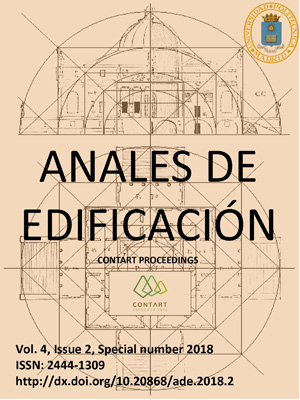Más allá de la rehabilitación en una obra emblemática: monitorización de las cubiertas del hipódromo de la Zarzuela = Beyond the rehabilitation in an emblematic work: monitoring the decks of the Zarzuela racecourse
DOI:
https://doi.org/10.20868/ade.2018.3780Palabras clave:
Hormigón, reparación, corrosión, monitorización, técnicas electroquímicas, Concrete, repair, corrosion, monitoring, electrochemical techniquesResumen
Resumen
El hipódromo de la Zarzuela, declarado patrimonio histórico nacional, fue construido en Madrid en los años 40, y es una obra del Ingeniero Eduardo Torroja y los arquitectos Arniches y Domínguez. Las cubiertas de su estructura son consideradas un arte desde el punto de vista ingenieril. A pesar del perfecto y genial equilibrio físico y mecánico, se iniciaron procesos físicos y físico-químicos de deterioro en su composición debido al largo periodo de exposición de la estructura a la acción climática y al ataque de los agentes agresivos atmosféricos, entre los cuales se destaca como principal patología la corrosión por carbonatación de su armadura embebida. Dada la importancia de la obra desde el punto de vista artístico, histórico y de seguridad, las autoridades correspondientes decidieron su rehabilitación. En este proyecto de reparación se contempló la instalación de un sistema de monitorización de medidas continuas, mediante sensores electroquímicos pasivos, capaces de indicar el riesgo de corrosión en la armadura embebida de la estructura. De este modo, es posible controlar el comportamiento del material frente a la interacción con la acción atmosférica y prever la posible necesidad de intervenciones de mantenimiento, evitando el avance del deterioro con rapidez y garantías. La implementación de la monitorización requirió de una evaluación mediante técnicas electroquímicas no-destructivas del grado de deterioro previo a la intervención, para poder estudiar la evolución del comportamiento de la estructura después de la reparación. En el presente trabajo, se presentan los resultados obtenidos tanto en la evaluación electroquímica previa en las cubiertas del Hipódromo de la Zarzuela, como su posterior monitorización durante casi 10 años. Se presenta también la viabilidad del sistema de monitorización y su fiabilidad con el tiempo.
Abstract
La Zarzuela racecourse, declared a national historical heritage, was built in Madrid in the 1940s, and is a work by Engineer
Eduardo Torroja and the architects Arniches and Domínguez. The covers of its structure are considered an art from the engineering
point of view. Despite the perfect and ingenious physical and mechanical balance, physical and physical-chemical processes of
deterioration in its composition were initiated due to the long period of exposure of the structure to climatic action and the attack of
aggressive atmospheric agents, among which the main pathology is the corrosion by carbonation of its embedded armor. Given the
importance of the work from the artistic, historical and security point of view, the corresponding authorities decided on its
rehabilitation. In this repair project, the installation of a continuous measurement monitoring system was contemplated, using passive
electrochemical sensors, capable of indicating the risk of corrosion in the structure's embedded reinforcement. In this way, it is possible
to control the behavior of the material against the interaction with atmospheric action and to foresee the possible need for maintenance
interventions, avoiding the advance of deterioration with speed and guarantees. The implementation of the monitoring required an
evaluation by non-destructive electrochemical techniques of the degree of deterioration prior to the intervention, in order to study the
evolution of the behavior of the structure after the repair. In the present work, the results obtained in the previous electrochemical
evaluation on the decks of the Hipódromo de la Zarzuela are presented, as well as their subsequent monitoring for almost 10 years.
The viability of the monitoring system and its reliability over time are also presented.
Descargas
Referencias
Andrade, C., Alonso, C., González, J.A. (1990) in: N.S. Berke, V. Chaker, D. Whiting (Eds.), Corrosion Rates of Steel in Concrete, ASTM STP, vol. 1065, American Society for Testing and Materials, Philadelphia, p. 29.
Andrade, C., Alonso, C., Gulikers, J., Polder, R., Cigna, R., Vennesland, O. and Salta, M. (2004). Test methods for on-site reinforcement corrosion rate measurement of steel reinforcement in concrete by menas of the
Polarization Resistance method. RILEM Recommendation of TC-154 “Electrochemical Techniques for measuring metallic corrosion”. Materials
and Structures vol 37, pp 623.643.
Andrade, C., Martínez, I., Castellote, M., Zuloaga, P. (2006).
Some principles of service life calculation of reinforcements and in situ corrosion monitoring by sensors in the radioactive waste containers of El Cabril
disposal (Spain). Journal of Nuclear Materials 358, 82–95.
ASTM C-876-91 (1995). ASTM, vol 04.02.
Feliú, S., González, J.A., Feliú, S.Jr., and Andrade, C. (1990). "Confinement of the electrical signal or in-situ measurement of Polarization Resistance in Reinforced concrete," ACI Mater. J., 87, pp 457.
Hipódromo de la Zarzuela. (1962). Informes de la Construcción, 154-6.
Martínez, I., Castillo, A., Andrade, C. (2008). “Non destructive electrochemical techniques applied to the corrosion evaluation of the liner structures in nuclear power plants”. Journal of Nuclear Materials. ELSEVIER. Volumen 373, 226-236.
Torroja, E. (1941). “Estructura de la Tribuna del nuevo Hipódromo de Madrid” Revista de Obras Públicas.
Torroja, E. (1958). “Madrid Racehouse” Architectural Record, VI.
UNE 112-0111-94 (1994). “Corrosión de armaduras. Determinación de la profundidad de carbonatación en hormigones endurecidos y puestos en servicio”.
Descargas
Publicado
Número
Sección
Licencia
1. Los autores conservan los derechos de autor y garantizan a la revista el derecho de una Licencia Creative Commons Atribución - Nocomercial 4.0 Internacional que permite a otros compartir el trabajo con un reconocimiento de la autoría y uso no comercial.
2. Los autores pueden establecer por separado acuerdos adicionales para la distribución no exclusiva de la versión de la obra publicada en la revista (por ejemplo, situarlo en un repositorio institucional o publicarlo en un libro).
Salvo indicación contraria, todos los contenidos de la edición electrónica se distribuyen bajo una licencia de uso y distribución “Creative Commons"












